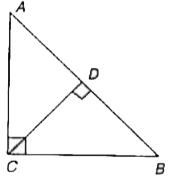ABC is a right angle triangle at A and AD is perpendicular to the hypotenuse. Then BDCD is equal to :
(ABAC)2
(ABAD)2
ABAC
ABAD
The correct Answer is:A
Step by step video, text & image solution for ABC is a right angle triangle at A and AD is perpendicular to the hypotenuse. Then (BD)/(CD) is equal to : by Maths experts to help you in doubts & scoring excellent marks in Class 14 exams.
Updated on:21/07/2023Topper's Solved these Questions
- GEOMETRYBook:ARIHANT SSCChapter:GEOMETRYExercise:INTRODUCTORY EXERCISE - 12.3
Explore 28 Videos
- GEOMETRYBook:ARIHANT SSCChapter:GEOMETRYExercise:INTRODUCTORY EXERCISE - 12.4
Explore 10 Videos
- GEOMETRYBook:ARIHANT SSCChapter:GEOMETRYExercise:INTRODUCTORY EXERCISE - 12.1
Explore 45 Videos
- FUNDAMENTALS Book:ARIHANT SSCChapter:FUNDAMENTALS Exercise:TEST OF YOU - LEARNING - 2
Explore 40 Videos
- HCF AND LCMBook:ARIHANT SSCChapter:HCF AND LCMExercise:Exercise Higher Skill Level Questions
Explore 18 Videos
Similar Questions
Knowledge Check
ABC is a right angle triangle at A and AD is perpendicular to the hypotenuse. Then BDCD is equal to :
A(ABAC)2B(ABAD)2CABACDABADABC is a triangle right angled at Aand a perpendicular AD is drawn on the hypotenuse BC. What is BC.AD equal to ?
AAB .ACBAB . ADCCA .CDDAD . DBABC is a triangle which is right angled at A and a perpendicular AD is drawn on the hypotenuse BC. If BC = 8 and AD = 3, then what is the value of AB×AC?
A12B24C32D36
ABC is a right-angled triangled, right angled at A⋅AD is drawn perpendicular to BC from A. Then AB2 is equal to
View Solution. In right angled triangle ABC,∠A is right angle. AD is perpendicular to the hypotenuse BC. Prove that ΔABCΔACD=BC2AC2
View SolutionΔABC is an isosceles triangle. AB = AC and BD is perpendicular on AC from vertex B, then BD2−CD2 is equal to-
View SolutionIn a right angled triangle ABC, CD is the perpendicular on the hypotenuse AB. Which of the following is correct?

View Solutiona and b are two side adjacent to the right angle of a right-angled triangle and p is the perpendicular drawn to the hypotenuse from the opposite vertex. Then p2 is equal to
View Solution
